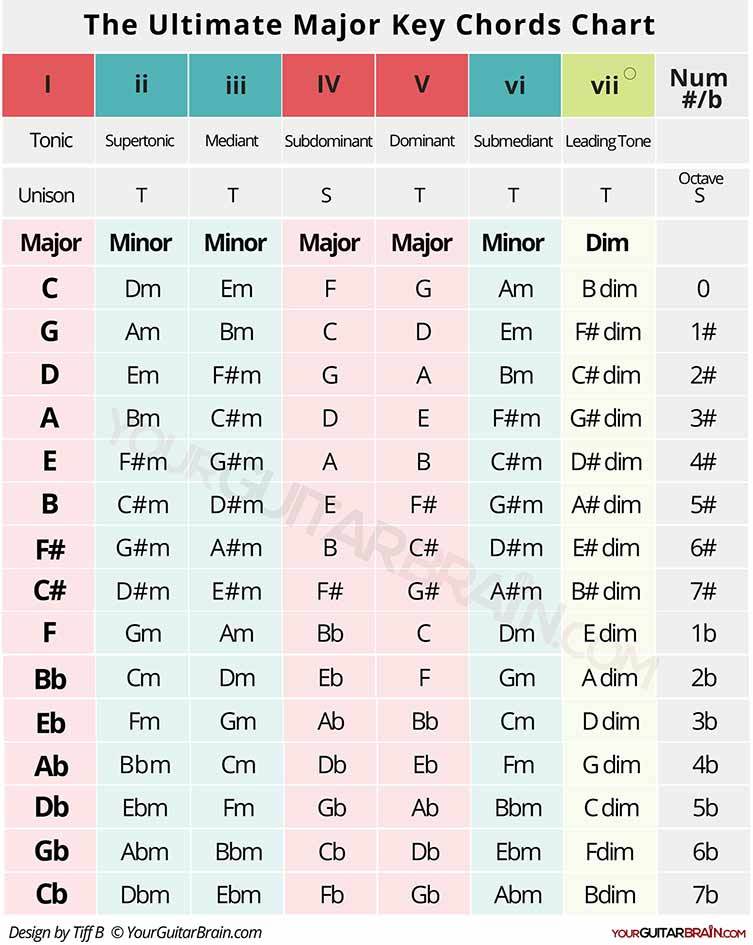
Don’t worry if this looks a little alien to you, much of what this chord consists of is drawn from more complicated kinds of music, but it’s useful to be able to see how a ‘complete’ version of a chord looks before we go back to see how it’s built from the beginning.

CHORDS AND THEIR NOTES FULL
What you’re looking at above is a visual representation of a C major chord with a full complement of extended tones. We’re talking about the kind of chords you find in Schubert lieder, Rachmaninoff preludes, Gershwin rhapsodies, and Billy Joel songs, along with huge amounts of other music both aged and modern.Īnd we get to start it all off with a nice little metaphor.

For our purposes, however, we’re going to stick to the good ol’ chordal basics as they’ve come to us through the tradition of Western classical music. There are many different kinds of chords to be found in many different musical contexts, and many questions addressing whether something even is a chord versus some other harmonic sonority. Of course, the explanation only gets more elaborate from there. This definition might be a little too simplistic, and a better way to define chords goes like this: a chord is a structured collection of notes used in music to convey harmony. The most simple definition you'll encounter is that a chord happens when two or more notes are played together.
CHORDS AND THEIR NOTES SERIES
From the broken chord figures built into Mozart’s sonatas meant to emulate the strings of an orchestra-to the modern day 12-year old with a guitar who's overjoyed to finally nail the third of those three chords necessary to become a rockstar, the world is virtually chord crazy.īut what is a chord? We can all play them, but can you describe one? Do you really know how chords are made? And more importantly, given that this is an article series dedicated to understanding keys, how can knowing about chords help us learn about how keys function?Īs with our previous article, in which we re-built our basic understanding of scales to put towards the greater goal of learning about keys, in this article we will seek out an understanding of chords that gives us both a solid groundwork regarding their construction and identification, and a greater insight into how they function when thinking of keys.įirst things first though, we need to make sure we have a solid grasp on what chords are and how they’re built. Instead of existing as the incidental result of a number of melodies coming together as in Renaissance music, in the Baroque Era, chords finally became an accepted texture unto themselves.Īnd things only became more, well, chordal from there. This was the precursor to the modern shorthand of chord symbols in jazz and pop charts, and it evolved in tandem with the increased inclusion of written chords for keyboard and stringed instruments. In figured bass, a bass line-a series of single notes in the bass- is accompanied by tiny numbers that indicate harmonic intervals to be played above each note. The Baroque Period witnessed the rise in popularity of a simple and effective manner of providing accompanists with harmonic directions called figured bass. Harmonies, the likes of which we might think of as chords or chord progressions, were the result of multiple melodic lines woven together. 1600-1750, the musical era of Bach, Handel, and Vivaldi), European music was generally based on linear material, that is to say, on melody. What are Chords and How Can They Help Us Learn About Keys?Ĭhords have been a staple device in the music of the Western world for, well, a long time.


 0 kommentar(er)
0 kommentar(er)
